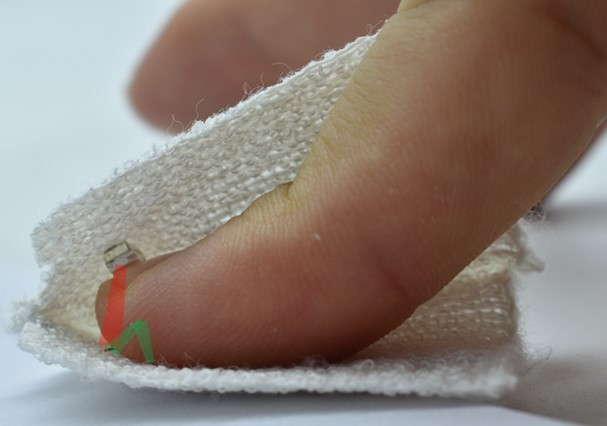-KIST researchers improve the performance of fiber-type optoelectronic devices by rolling the desired shape electrode into a thread
-Heart rate can be measured at the fingertips by inserting a fibrous photodiode into the fabric
 |
| A photo showing that a device manufactured to monitor human signals is inserted into a fiber and optical blood flow can be measured with an LED.[KIST 제공] |
[헤럴드경제=구본혁 기자] Along with the development of wearable devices (wearable devices), electronic fiber technology that combines light and comfortable fibers with smart electronic devices is drawing attention as a next-generation new technology. In particular, a fibrous electronic device having electrical characteristics while maintaining the inherent characteristics of a fiber is one of the key devices for implementing an electronic fiber.
In general, in optoelectronic devices composed of layers such as semiconductors, electrodes, and insulating films, the device performance varies greatly depending on the size and structure of the electrodes. In order to make a fibrous electronic device, it bends easily and the device must be formed on a thin thread, so the size of the device cannot be made larger than the thickness of the thread in micrometer units, so there is a limit to improving the performance of the device. A technology that can improve the performance of electronic fibers beyond these limitations has been developed by a domestic research team.
The research team of Dr. Hyun-Jung Lee and Jeong-A Lim of the Next-Generation Semiconductor Research Institute of Korea Advanced Institute of Science and Technology (KIST) prints the desired electrode with an inkjet printer, then rolls the electrode thread coated with a semiconductor on it. It announced on the 24th that it has developed a technology to manufacture fiber-type electronic devices such as diodes.
In 2019, Dr. Hyun-Jung Lee’s research team developed a technology that printed carbon nanotube (CNT) ink on a hydrogel substrate, a polymer containing water, and then transferred and formed an electrode on a desired surface. The CNT electrode printed on the hydrogel is like floating in water, and it is expected that if the fiber is rolled on it, it can be easily transferred to the surface of the fiber without damaging the electrode structure. As a result of a study with Dr. Jeong-ah Lim’s research team, the actual semiconductor layer and CNT A high-performance fibrous device was fabricated without damaging the electrode. The fibrous transistor wrapped with the developed CNT electrode maintained stable performance of more than 80% even when it was bent to a 1.75mm bending radius.
 |
| A schematic diagram of a strategy for implementing a photoelectric device for monitoring human body signals through CNT electrode transcription.[KIST 제공] |
In addition, by using the translucent properties of the CNT electrode, a fiber-type photodiode that can detect light was fabricated by wrapping the electrode seal coated with a semiconductor layer that can generate current by absorbing light. The fabricated fibrous photodiode can detect light in a wide visible light range and has excellent sensitivity that is not inferior to that of planar devices. When the fiber-type photodiode developed by the research team is inserted into a cloth with an LED element and worn like a glove, the fiber-type photodiode can measure the user’s pulse by detecting the intensity of reflection of the LED light that changes according to the change in the amount of blood flowing from the fingertip. there was.
Dr. Lee Hyun-jung said, “This research presents a new approach to electrode formation technology, which remains a task in the development of fiber-type devices, and can accelerate the development of fibrous electronic devices with complex circuits from improving the performance of fiber-type optoelectronic devices. I look forward to it.”
The research results were published in the latest issue of’ACS Nano’, an international academic journal in the field of nanomaterials.
